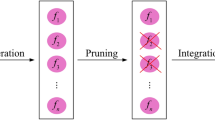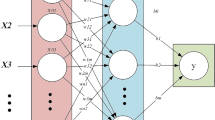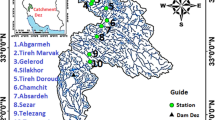Abstract
Streamflow simulation, particularly in ungauged watersheds, poses a significant challenge in surface water hydrology. The estimation of natural river and streamflow has been a research focus in recent years, with numerous strategies proposed. Hybrid ensemble soft computing models have proven their effectiveness in predicting flow rates. This study proposes a modeling approach that integrates a support vector machine (SVM) with several ensemble learning techniques, such as Bagging, Dagging, Random subspace, and Rotation Forest, to predict flow rates in natural rivers of a Mediterranean climate in Algeria. The gauging data of the hydrometric station “Amont des gorges” were used, and the following quantitative parameters were considered: flow, velocity, depth, width, and hydraulic radius. The proposed models were evaluated based on Nash–Sutcliffe efficiency (NSE), root mean square error (RMSE), and correlation coefficient (R). Our results indicated that the ensemble models outperformed the standalone SVM model. More specifically, the SVM-Dagging model performed the best, with RMSE = 6.58, NSE = 0.76 and R = 0.96, followed by SVM-Bagging (RMSE = 6.83, NSE = 0.75, and R = 0.96), SVM-RF (RMSE = 6.95, NSE = 0.74, and R = 0.95), SVM-RSS (RMSE = 8.34, NSE = 0.62, and R = 0.93), and the standalone SVM models (RMSE = 7.71, NSE = 0.68, and R = 0.88), respectively. These findings suggest that the proposed ensemble models are valuable tools for accurately forecasting stream and river flows, aiding planners and decision-makers. Accurate prediction of flow rates in natural rivers can enhance water resource planning, optimize resource allocation, and improve water management practices.




Similar content being viewed by others
Availability of Data and Materials
The data that support the findings of this study are available on request.
References
Adnan RM, Jaafari A, Mohanavelu A, Kisi O, Elbeltagi A (2021) Novel ensemble forecasting of streamflow using locally weighted learning algorithm. Sustainability 13(11):5877
Adnan Ikram R, Khan I, Moayedi H, Dehrashid AA, Elkhrachy I, Le BN (2023) Novel evolutionary-optimized neural network for predicting landslide susceptibility. Environ Dev Sustain 1–33
Atashi V, Barati R, Lim YH (2023) Improved river flood routing with spatially variable exponent muskingum model and sine cosine optimization algorithm. Environ Process 10(42):1–20
Blöschl G, Hall J, Viglione A, Perdigão RA, Parajka J, Merz B et al (2019) Changing climate both increases and decreases European river floods. Nature 573(7772):108–111
Breiman L (1996) Bagging predictors. Mach Learn 24:123–140
Chen Sh, Zhang H, Zykova KI, Gholizadeh Touchaei H, Yuan C, Moayedi H, Le BN (2023) Computational intelligence models for predicting the frictional resistance of driven pile foundations in cold regions. Comput Concr 32(2):217–232
Cortes C, Vapnik V (1995) Support-vector networks. Mach Learn 20:273–297
Gao C, Hao M, Chen J, Gu C (2021) Simulation and design of joint distribution of rainfall and tide level in Wuchengxiyu Region. China Urban Clim 40:101005
Gong S, Bai X, Luo G, Li C, Wu L, Chen F, Zhang S (2023) Climate change has enhanced the positive contribution of rock weathering to the major ions in riverine transport. Glob Planet Change 228:104203
Guo Y, Zhang Y, Zhang L, Wang Z (2021) Regionalization of hydrological modeling for predicting streamflow in ungauged catchments: A comprehensive review. Wiley Interdiscip Rev Water 8(1):e1487
Hafied Y, Marouf N, Bouziane MT, Remini B, Lubomir S (2019) Load sediments quantification in Algerian north-west basins by ANN (artificial neurons network) method. Geosci Eng 65(3):1–17
He M, Dong J, Jin Z, Liu C, Xiao J, Zhang F, Deng L (2021) Pedogenic processes in loess-paleosol sediments: Clues from Li isotopes of leachate in Luochuan loess. Geochim Cosmochim Acta 299:151–162
Ibrahim KSMH, Huang YF, Ahmed AN, Koo CH, El-Shafie A (2022) A review of the hybrid artificial intelligence and optimization modelling of hydrological streamflow forecasting. Alex Eng J 61(1):279–303
Kuncheva L. I Rodríguez, J. J (2007) An experimental study on rotation forest ensembles. In Multiple Classifier Systems: 7th International Workshop, MCS 2007, Prague, Czech Republic, May 23–25 (2007) Proceedings 7. Springer, Berlin Heidelberg, pp 459–468
Li J, Wang Z, Wu X, Xu C, Guo S, Chen X (2020) Toward Monitoring Short-Term Droughts Using a Novel Daily Scale, Standardized Antecedent Precipitation Evapotranspiration Index. J Hydrometeorol 21(5):891–908
Li Q, Lu L, Zhao Q, Hu S (2023) Impact of Inorganic Solutes’ Release in Groundwater during Oil Shale In Situ Exploitation. Water 15(1):172
Luo J, Niu F, Lin Z, Liu M, Yin G, Gao Z (2022) Abrupt increase in thermokarst lakes on the central Tibetan Plateau over the last 50 years. Catena 217:106497
Ma S, Qiu H, Yang D, Wang J, Zhu Y, Tang B, Cao M (2023) Surface multi-hazard effect of underground coal mining. Landslides 20(1):39–52
Marouf N (2012) Study of water quality and sediment transport in the Beni-Haroun dam (MILA): Its impact on the environment of the region. Mohamed Khider University, Biskra, Algeria, p 242
Marouf N, Remini B (2011) Temporal variability in sediment concentration and hysteresis in the Wadi Kebir Rhumel Basin of Algeria. HKIE Transactions 18(1):13–21
Meddi M, Toumi S, Assani AA (2017) Application of the L-moments approach to the analysis of regional flood frequency in Northern Algeria. Int J Hydrol Sci Technol 7(1):77–102
Moayedi H, Dehrashid AA (2023) A new combined approach of neural-metaheuristic algorithms for predicting and appraisal of landslide susceptibility mapping. Environ Sci Pollut Res 30:82964–82989
Moayedi H, Varamini N, Mosallanezhad M, Foong LK, Le BN (2022) Applicability and comparison of four nature-inspired hybrid techniques in predicting driven piles’ friction capacity. Transp Geotech 37:100875
Moayedi H, Salari M, Dehrashid AA, Le BN (2023) Groundwater quality evaluation using hybrid model of the multi-layer perceptron combined with neural-evolutionary regression techniques: case study of Shiraz plain. Stoch Environ Res Risk Ass 37:2961–2976
Moramarco T, Singh VP (2001) Simple method for relating local stage and remote discharge. J Hydrol Eng 6(1):78–81
Muhammetoglu A, Orhan P, Akdegirmen O, Dugan ST, Muhammetoglu H (2023) An Integrated Modeling Approach to Assess Best Management Practices (BMPs) for Improving Stream Water Quality Using the MapShed and WASP8 Models. Water Resour Manage 10:1–7
Nhu VH, Janizadeh S, Avand M, Chen W, Farzin M, Omidvar E et al (2020) GIS-based gully erosion susceptibility mapping: a comparison of computational ensemble data mining models. Appl Sci 10(6):2039
Ni L, Wang D, Singh VP, Wu J, Wang Y, Tao Y, Zhang J (2020) Streamflow and rainfall forecasting by two long short-term memory-based models. J Hydrol 583:124296
Pham BT, Jaafari A, Van Phong T, Yen HPH, Tuyen TT, Van Luong V et al (2021) Improved flood susceptibility mapping using a best first decision tree integrated with ensemble learning techniques. Geosci Front 12(3):101105
Pham BT, Nguyen-Thoi T, Qi C, Van Phong T, Dou J, Ho LS et al (2020) Coupling RBF neural network with ensemble learning techniques for landslide susceptibility mapping. Catena 195:104805
Qiu D, Zhu G, Bhat MA, Wang L, Liu Y, Sang L, Sun N (2023) Water use strategy of nitraria tangutorum shrubs in ecological water delivery area of the lower inland river: Based on stable isotope data. J Hydrol 624:129918
Rhomad H, Khalil K, Elkalay K (2023) Water Quality Modeling in Atlantic Region: Review, Science Mapping and Future Research Directions. Water Resour Manage 37(1):451–499
Rui S, Zhou Z, Jostad HP, Wang L, Guo Z (2023) Numerical prediction of potential 3-dimensional seabed trench profiles considering complex motions of mooring line. Appl Ocean Res 139:103704
Saha S, Kundu B, Paul GC, Pradhan B (2023) Proposing an ensemble machine learning based drought vulnerability index using M5P, dagging, random sub-space and rotation forest models. Stoch Environ Res Risk Assess 1–28
Sahoo A, Samantaray S, Ghose DK (2019) Stream flow forecasting in Mahanadi River Basin using artificial neural networks. Procedia Comput Sci 157:168–174
Samantaray S, Sahoo A, Ghose DK (2020) Assessment of sediment load concentration using SVM, SVM-FFA and PSR-SVM-FFA in arid watershed, India: a case study. J Civ Eng 24:1944–1957
Samantaray S, Sahoo A, Agnihotri A (2023) Prediction of Flood Discharge Using Hybrid PSO-SVM Algorithm in Barak River Basin. MethodsX 10:102060
Swain JB, Patra KC (2017) Streamflow estimation in ungauged catchments using regionalization techniques. J Hydrol 554:420–433
Tao H, Al-Sulttani AO, Salih Ameen AM, Ali ZH, Al-Ansari N, Salih SQ, Mostafa RR (2020) Training and testing data division influence on hybrid machine learning model process: application of river flow forecasting. Complexity 8844367:1–22
Taylor KE (2001) Summarizing multiple aspects of model performance in a single diagram. Journal of Geophysical Research: Atmospheres 106(D7):7183–7192
Ting KM, Witten IH (1997) Stacking bagged and dagged models. In: Proceeding ICML '97 Proceedings of the Fourteenth International Conference on Machine Learning. 367–375. ISBN:1-55860-486-3
Tran QC, Minh DD, Jaafari A, Al-Ansari N, Minh DD, Van DT et al (2020) Novel ensemble landslide predictive models based on the Hyperpipes algorithm: a case study in the Nam Dam Commune. Vietnam Appl Sci 10(11):3710
Tuyen TT, Jaafari A, Yen HPH, Nguyen-Thoi T, Van Phong T, Nguyen HD et al (2021) Mapping forest fire susceptibility using spatially explicit ensemble models based on the locally weighted learning algorithm. Ecol Inform 63:101292
Wang X, Wang T, Xu J, Shen Z, Yang Y, Chen A, Piao S (2022) Enhanced habitat loss of the Himalayan endemic flora driven by warming-forced upslope tree expansion. Nat Ecol Evol 6(7):890–899
Yadav B, Gupta PK, Patidar N, Himanshu SK (2020) Ensemble modelling framework for groundwater level prediction in urban areas of India. Sci Tot Environ 712:135539
Yaseen ZM, Ebtehaj I, Bonakdari H, Deo RC, Mehr AD, Mohtar WH, Diop L, El-Shafie A, Singh VP (2017) Novel approach for streamflow forecasting using a hybrid ANFIS-FFA model. J Hydrol 554:263–276
Yaseen ZM, Sulaiman SO, Deo RC, Chau KW (2019) An enhanced extreme learning machine model for river flow forecasting: State-of-the-art, practical applications in water resource engineering area and future research direction. J Hydrol 569:387–408
Yin L, Wang L, Li T, Lu S, Tian J, Yin Z, Zheng W (2023) U-Net-LSTM: Time Series-Enhanced Lake Boundary Prediction Model. Land 12(10):1859
Zhao Y, Gor M, Voronkova DK, Gholizadeh Touchaei H, Moayedi H, Le BN (2023) An optimized ANFIS model for predicting pile pullout resistance. Comput Concr 48(2):179–190
Zhou G, Yang Z (2023) Analysis for 3-D morphology structural changes for underwater topographical in Culebrita Island. Int J Remote Sens 44(7):2458–2479
Zhou G, Wu G, Zhou X, Xu C, Zhao D, Lin J, Zhang L (2023) Adaptive model for the water depth bias correction of bathymetric LiDAR point cloud data. Int J Appl Earth Obs Geoinf 118:103253
Zhu G, Liu Y, Shi P, Jia W, Zhou J, Liu Y, Zhao K (2022) Stable water isotope monitoring network of different water bodies in Shiyang River basin, a typical arid river in China. Earth Syst Sci Data 14(8):3773–3789
Funding
This research received no specific grant from any funding agency in the public, commercial, or not-for-profit sectors.
Author information
Authors and Affiliations
Contributions
Conceptualization, Yahi Takai Eddine, Marouf Nadir, and Sehtal Sabah; Data acquisition, Yahi Takai Eddine, Marouf Nadir, and Sehtal Sabah; Methodology, Abolfazl Jaafari; Writing-original draft preparation, Yahi Takai Eddine, Marouf Nadir, Sehtal Sabah, Abolfazl Jaafari; Writing-review and editing, Abolfazl Jaafari.
Corresponding author
Ethics declarations
Ethical Approval
All research activities conducted for this article have obtained ethical approval from the relevant institutional review board or ethics committee. This ensures that the research complies with ethical standards and safeguards the rights and well-being of the participants.
Consent to Participate
Participants involved in this study have provided informed consent to voluntarily participate. Clear and comprehensive information regarding the study's purpose, procedures, and potential risks has been communicated, allowing participants to make informed decisions about their involvement.
Consent to Publish
Authors have obtained explicit consent from study participants, when applicable, for the publication of any identifiable information. This ensures respect for individuals' privacy and confidentiality, aligning with ethical publishing practices.
Competing Interests
Authors disclose any competing interests that could influence the interpretation or presentation of the research. This includes financial interests, relationships, or affiliations that may be perceived as influencing the work.
Additional information
Publisher's Note
Springer Nature remains neutral with regard to jurisdictional claims in published maps and institutional affiliations.
Rights and permissions
Springer Nature or its licensor (e.g. a society or other partner) holds exclusive rights to this article under a publishing agreement with the author(s) or other rightsholder(s); author self-archiving of the accepted manuscript version of this article is solely governed by the terms of such publishing agreement and applicable law.
About this article
Cite this article
Takai Eddine, Y., Nadir, M., Sabah, S. et al. Integrating Support Vector Machines with Different Ensemble Learners for Improving Streamflow Simulation in an Ungauged Watershed. Water Resour Manage 38, 553–567 (2024). https://doi.org/10.1007/s11269-023-03684-w
Received:
Accepted:
Published:
Issue Date:
DOI: https://doi.org/10.1007/s11269-023-03684-w




